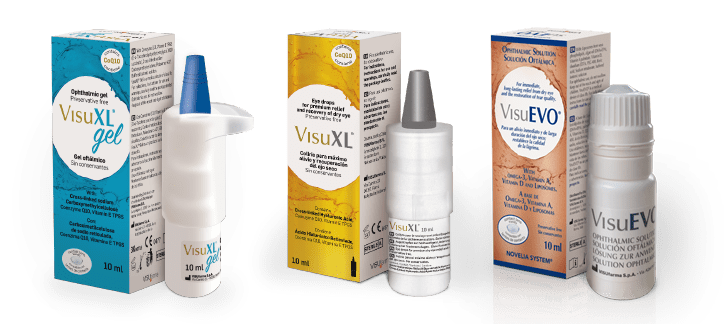How to Manage Dry Eye If You Wear Contact Lenses
It is commonly assumed that Dry Eye Syndrome and contact lenses don’t mix. However, it is possible to wear contacts if you have Dry Eye, it’s just not easy. Our blog explains everything you need to know about contact lenses and managing Dry Eye Syndrome.
Does wearing contact lenses cause dry eyes?
Contact lenses can aggravate Dry Eye because the presence of the lens on the cornea limits oxygen flow into the eye, and oxygen is necessary to develop natural tears.[1] Natural tears play a huge role in supporting the health of our eyes, as they lubricate and nourish the eye to wash away foreign materials and keep the surface of the eye smooth and clear. Therefore, contact lenses can soon make eyes feel dry and uncomfortable, particularly at the end of the day.
The lens material also limits tear exchange between the outer and inner layers of the eye. Soft contact lenses also absorb moisture from your eye to stay hydrated and soft, hence why your eyes can dry out when wearing them.[2]
Are daily contact lenses better for dry eyes?
According to clinical research, the use of daily disposable contact lenses can reduce eye dryness and improve comfort.[3] This is because these types of lenses have a lower risk of collecting dirt and debris as they’re only used once. In contrast to this, monthly contact lenses can be stored for 30 days so have a higher chance of building up dirt and protein deposits, which can cause dryness and discomfort.[1]
How do you know if you have dry eyes with contacts?
Dry Eye can cause many symptoms such as pain in the eyes, a gritty feeling or blurred vision. Below is the full list of Dry Eye symptoms that you may experience:
- Stinging or burning in the eyes
- A feeling of grit in the eye
- Stringy mucus near the eyes
- Watery eyes
- Redness
- Light sensitivity[4]
To understand more about Dry Eye Syndrome, click here: Everything you Need to Know About Dry Eye.
How do you fix dry eyes from contacts?
Luckily, there are several things you can do to make contact lens use with Dry Eye Syndrome more comfortable. From changing your solution to using eye drops, keep reading to discover some of our top tips for managing your dry eye symptoms when you wear contact lenses.
Practice good hand hygiene:
This minimises the risk of transferring germs from fingers to the lens, which can cause infections and aggravate existing dry eye problems. To follow good hand hygiene, follow the below five steps:
- Wet your hands with clean water from the tap
- Apply soap and lather your hands by rubbing your hands together with the soap. Ensure that you scrub under the fingernails and between your fingers.
- Scrub your hands for at least 20 seconds.
- Rinse your hands well.
- Dry your hands using a clean towel.[5]
You can also help to reduce the spread of germs by trying not to touch your face and eyes with unwashed hands.
Never sleep with your contacts in:
Unless you use extended-wear lenses or ortho-k lenses, never sleep with your contact lenses in. Sleeping in your contacts can often happen by accident, but it makes you six times more likely to get an eye infection. If you do accidentally fall asleep with your contact lenses in, there are a few steps you can take to help minimise any damage to your eyes.
- Don’t be tempted to try to take your contact lenses out straight away as they’ll be very dry and could be stuck to your eyes. Wait a little while, massage your eyes and apply eye drops if necessary before removing them.
- Drink lots of water to help rehydrate.
- Take a day off your contacts to give your eyes the rest they need.
- If your eyes are still feeling uncomfortable after a few days, give your optician a call or speak to a healthcare professional for advice.
Use new contact lens solution every day:
Don’t top up or reuse contact solution from one day to the next. It is much better for your eyes to empty out the solution as soon as you’ve taken out the contacts, and replace it with fresh liquid. Reusing contact lens solution can decrease the effectiveness of its disinfection properties, which can lead to inflammation.[6]
Always change to a fresh pair of lenses as directed:
It is normal to accidentally use a pair of contacts beyond their recommended time if we are busy and forget to switch to a new pair. It seems relatively harmless but can lead to a build-up of debris on the lens surface. This can be very damaging to the eyes, increasing the risk of irritation and infection.
Go contact lens free for a few hours a day:
Your eyes need to breathe, as without oxygen and nutrients they can’t make enough tears. Give your eyes a break from contact lenses for a few hours a day, every day, preferably before bed.[6]
Use eye drops that are contact lens friendly:
All of the VisuFamily range of products are contact lens friendly and designed to provide long-lasting protection and relief to improve the quality of life for patients living with Dry Eye Syndrome.
For more information about eye drops that are contact lens friendly, click here: VISUfarma UK.
In most cases, the best way to treat dry eyes, Also known as dry eye syndrome, is to use eye gel or eye drops.
VisuXL Gel® is a preservative-free smart gel lubricant for dry eye syndrome. It provides comfort in a bottle with it’s long-lasting lubrication properties giving 12-hour dosing with just one drop and is suitable for both day and night use.
VisuXL® is a preservative-free eye drop lubricant for dry eye syndrome. Due to its unique ingredients, VisuXL® will help you recover from eye surgery, an injury or persistent damaging dry eye.
VisuEvo® is a preservative-free eye drop that prevents excessive evaporation of the tear film. Its unique formula contains omega-3 essential fatty acids, Vitamins A and D and ultra-filtered phospholipids that facilitate tear film presentation and control evaporation.
All three products are contact lens-friendly and can be used for 180 days after opening.
Shop now
References
- Specsavers, ‘Your Guide to Wearing Contact Lenses for Dry Eyes’. Accessed September 2021.
- Roswell Eye Clinic, ‘Dry Eye and Cornea’. Accessed June 2023.
- Riley C, Young G, Chalmers R. Prevalence of ocular surface symptoms, signs, and uncomfortable hours of wear in contact lens wearers: the effect of refitting with daily-wear silicone hydrogel lenses (senofilcon a). Eye Contact Lens. 2006 Dec;32(6):281-6. Accessed May 2023.
- NHS, ‘Dry Eyes’. Accessed June 2023.
- Centers for Disease Control and Prevention, ‘Keeping Hands Clean’. Accessed May 2023.
- Miller, Korin. ‘8 Contact Lens Rules People With Dry Eyes Should Always Follow’, Self, 09/2018. Accessed September 2021.




